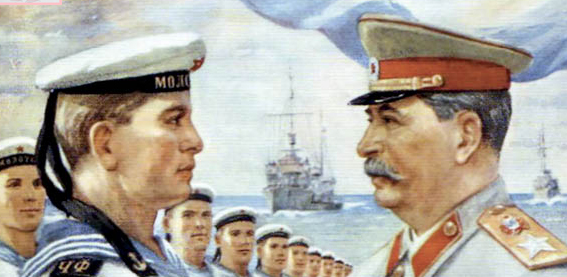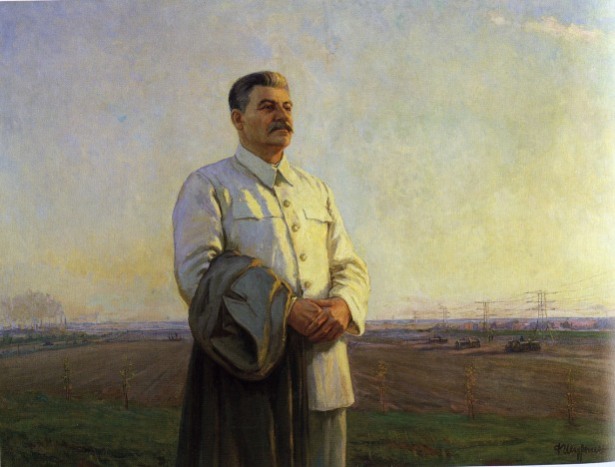
Petr Golub’ (Голубь, П.), Stalin raised us to be loyal to the people! (Нас вырастил Сталин – на верность народу!), 1948
Stalin poster of the week is a weekly excursion into the fascinating world of propaganda posters of Iosif Stalin, leader of the USSR from 1929 until his death in 1953.
Here, Anita Pisch will showcase some of the most interesting Stalin posters, based on extensive research in the archives of the Russian State Library, and analyse what makes these images such successful propaganda.
Anita’s fully illustrated book, The personality cult of Stalin in Soviet posters, 1929 -1953, published by ANU Press, is available for free download here, and can also be purchased in hard copy from ANU Press.
The 1944 version of the Soviet national anthem includes the lines ‘And Stalin raised us to be loyal to the people / Inspired us to work and to deeds’, formalising Stalin’s patriarchy as a matter of state.
The first line is quoted directly in a 1948 postwar poster by Petr Golub’. The lyrics of the anthem were, of course, well known and instantly recognisable to the Soviet people, and the two lines preceding this one glorify Lenin, ‘Through storms the sun of freedom shone on us / And great Lenin lit up our path’. However, Lenin is nowhere to be seen in this poster, either in text or image.
‘Stalin raised us to be loyal to the people!’ combines the Father and Warrior archetypes in one pastel image. The poster caption makes clear the dual nature of Stalin’s role for the sailors — as the Generalissimus of the Armed Forces, he is their military leader and as the man who raised them, he is their symbolic father.

Naval ensign of the Soviet Union
Under the protective canopy of the Soviet Navy flag, Stalin inspects the troops and addresses a young sailor who has been pulled out of line.
Stalin and the sailor stand eye-to-eye, the sailor holding the leader’s gaze. They look remarkably alike in terms of facial features, almost as if they could be related.

The young sailor meets Stalin’s gaze without fear
Unusually, Stalin is shown as the same height as the young man, although the peak of his cap makes his overall height slightly greater.
The sailor’s cap shows that he is attached to the cruiser named ‘Molotov’ (after Vyacheslav Molotov). The project 26bis Kirov-class cruiser of the Soviet Navy served during World War II and into the Cold War, supporting Soviet troops during the Siege of Sevastopol (1941-2), the Kerch-Feodosiya Operation (1941) and the amphibious landings at Novorossiysk in 1943.
The flag that flies overhead is the Soviet Navy ensign flag. It is white with a sky blue strip across the base, and big red star in hoist and red sickle and hammer in fly. It is seen in reverse in this depiction.
This ensign was adopted by the decision of the Central Executive Committee and Council of People’s Commissioners on 27 May 1935. It was first hoisted on naval ships on 1 July 1935.
Anita Pisch‘s book, The personality cult of Stalin in Soviet posters, 1929 – 1953, is now available for free download through ANU Press open access, or to purchase in hard copy for $83. This lavishly illustrated book, featuring reproductions of over 130 posters, examines the way in which Stalin’s image in posters, symbolising the Bolshevik Party, the USSR state, and Bolshevik values and ideology, was used to create legitimacy for the Bolshevik government, to mobilise the population to make great sacrifices in order to industrialise and collectivise rapidly, and later to win the war, and to foster the development of a new type of Soviet person in a new utopian world.
Dr Anita Pisch’s website can be found at www.anitapisch.com





